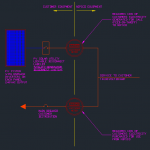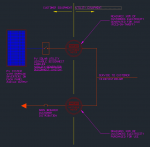I am adding a tariff meter for solar. I have a couple of questions:
1. Best way to tap the incoming line at the existing meter?
2. Does the utility supply still land on the top of the new meter socket?
3. On the PV disconnect to the tariff meter, does the PV feed land on the line or load side of the disconnect?
1. Utilities commonly do not allow any foreign connectors in a socket dedicated to their meter, such as insulation pierceing connectors or Polaris tap connectors. If the meter socket is equipped for two wires to terminate the way the manufacturer sells it, which is common for 320A meter sockets, then it is OK to use an otherwise-vacant terminal to connect your system. But if you need to use any connector that is not sold as an accessory to the meter socket, you should plan on making that connection either in a separate enclosure, or in a different enclosure such as your main panelboard.
2. You'll need to check with the utility on what their standard is, for this. The most common answer in my area is yes. This means the sign convention is consumption is positive, and production is negative, just as it is for a service meter that is only for loads. For a customer-owned meter that doesn't concern the utility by contrast, like a Locus meter, your monitoring platform would specify the convention, and it is most common to wire it so production is positive.
3. The "hinge" of the disconnect blades should be oriented toward the inverter. This way the blades and fuses if applicable, are de-energized in the open position. The part of the circuit that doesn't get de-energized by that particular switch, should land on its line-side terminals. Heavy-duty disconnects have plastic shields that guard against accidental contact to the still-energized terminals on the line size. Make sure this is called out clearly on your drawing, so it doesn't get overlooked. I find it helpful to rotate the schematic drawing of the unit so it matches the up/down orientation it has in reality, and articulate the wiring to its top and bottom. That way, the wiring orientation is deliberate and obvious.
I will also add that utilities typically have a standard about the sequence of the meter socket and service disconnect. Factors that affect the answer, are the nominal voltage, and whether the meter is self-contained or uses a CT cabinet. The terms are hot sequence and cold sequence. Hot sequence means the meter socket remains "hot" after the main service disconnect is opened. Cold-sequence means the customer can open their main service disconnect, and de-energize the meter.





